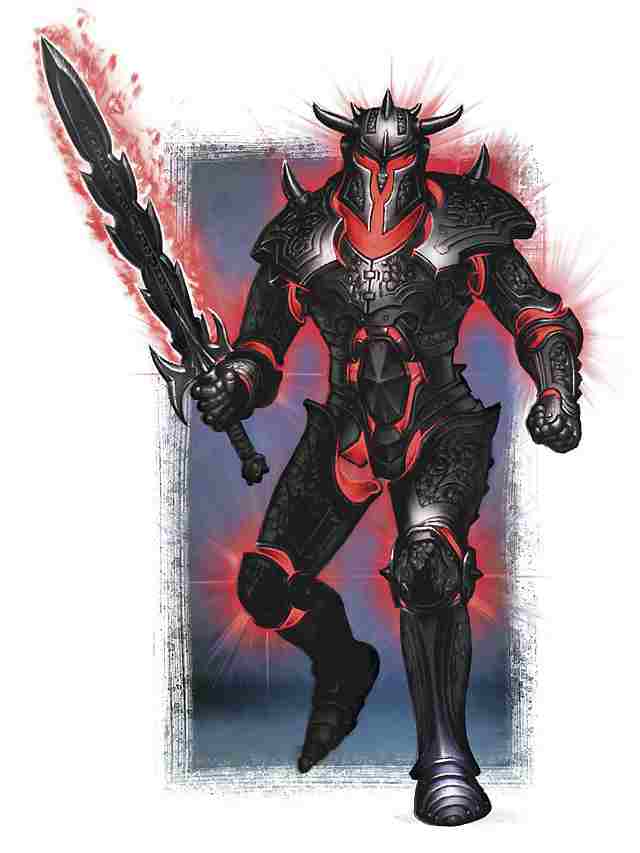By Alan McCoy from Dungeons & Dragons: Fundamentals
How to build challenging encounters against a Helmed Horror
Note: This has been prepared utilizing only the 5E Core Rules. The Helmed Horror can be found in the Monster Manual page 183.
The Helmed Horror is a medium sized humanoid shaped construct that possesses intelligence, the ability to reason, the ability to adjust its tactics and an unswerving devotion to it maker. This devotion persists even after the makers demise.
Contained within an animated suit of plate armor, the Helmed Horror serves without ambition or emotion.
Helmed Horrors are constructed in matching sets of two, four, eight or more. A matching set is called a Cohort. If encountered in a group with others of its cohort, their tactics and actions will mesh perfectly and complementary. Even without its mates, they are formidable warriors and are often given command over other constructs or animations.
A Helmed Horror is intelligent enough to discern the difference between the literal wording of an order and the intent of an order. While the construct is self is without alignment, the orders given to it will cause its actions to reflect the beliefs and viewpoints of its maker. If that creator is evil, then it will perform acts that would be considered evil, but without malice. It is simply following orders.
Step 1) Let’s Review what we know about the Helmed Horror.
Exceptional Strength, Very High Constitution, Above Average Dexterity, Average in Intelligence, Wisdom and Charisma. Still when you consider that MOST constructs have no personality whatsoever, the Helmed Horror is Amazing in this regard.
Helmed Horrors are Vigilant, with a +4 to their perception skill.
Helmed Horrors take half damage from non-magical or non-adamantine weapon attacks (bludgeoning, piercing or slashing)
Helmed Horrors are immune to damage from Force, Necrotic or Poison
Helmed Horrors have Conditional Immunity to Blinded, Charmed, Deafened, Frightened, Paralyzed, Petrified, Poisoned and Stunned.
Helmed Horrors are Resistant to Magic and have advantage on saving throws against spells and other magical effects.
Helmed Horrors are COMPLETELY IMMUNE to the effects of THREE SPELLS chosen by its creator. These spells do not need to be the same for every element in the cohort. Typical Spells might include: Fireball, Lightning Bolt and Magic Missile.
Helmed Horrors can Fly or Walk 30 feet/round. They can Hover.
Helmed Horror Senses include both Normal Vision and Blindsight (60-foot radius)
Helmed Horrors are intelligent and can understand any of the languages of its creator but cannot speak.
As constructs, Helmed Horrors to not need to consume (food or drink), breath or sleep. Helmed Horrors have no physical body.
Step 2) Determine the probable Strategy.
As thinking constructs, the Helmed Horror will have been tasked with an objective by its creator, it will do its best to perform that task or die trying. Common tasks include guarding and preventing entry, attacking an objective until the opposition is destroyed, or others.
Helmed Horrors will adjust their tactics and reposition as needed to accomplish their mission.
Because both the creator and the Helmed Horror are thinking beings, it is impossible to detail all the multiple strategies that they can use, but it is reasonable to assume that the Horror would have been programed with the best possible tactics in mind.
Let’s assume that small cohort (Pair) of Helmed Horror has been tasked with defending a small courtyard outside the entrance to an evil temple while a ritual is taking place. They have at their disposal thirty animated skeletons over which they have been given command. Since the Helmed Horrors cannot speak, they have been ordered to respond to a colored light system upon the Helmed Horror Shields (Continual Flame spell covered by Gemstones).
Step 3) Determine Tactics
The Helmed Horrors will position up to half of their skeletal minions on the battlements as archers. One of the Horrors will take position there as well.
The other horror and the rest of the skeletons will position themselves below, spread out so that area of effect attacks will be of limited use.
The Helmed Horrors will place themselves in positions of observation scanning constantly for trouble to arrive. (Passive Perception 14).
They will especially look at the more likely points of entry.
If an intruder appears, the Horror in command of the archers will direct fire into the courtyard. Then attempt to identify spell-casters or weaker members of the intruding party.
Once identified, the Horror will direct additional arrows in that direction and fly down to engage those foes directly.
The Horror can determine if it is better to simply attack an opponent, or to utilize another attack action, perhaps a shove to send an opponent prone.
The Horror can choose to utilize its powerful Multi-Attack Longsword and can also utilize a bonus attack with a shield bash (+4 to Hit, d4+4 damage) (goose and gander) each round.
The Horror has the full slate of combat attack actions available to it, but will typically only use Attack, Dash, Disengage, Dodge, Help, Ready, or Use an Object. If the Creator has given them special instructions regarding the use of magical items, the Horror can trigger them.
The Horror could reasonably have been ordered to trigger a ballista or a multiple arrow launcher into a melee.
Step 4: DM Tips
Some things to think about before you start emplacing Helmed Horrors. They are very expensive. They are made from Adamantine Plate Armor; even normal plate armor is a staggering 1500 gold per suit. Then add in the additional costs of the special metals and enchantment. Each guardian would run at least 5,000 gold.
In order to afford to employ a Helmed Horror would require someone with both great resources and a need for completely loyal guardians. Most likely this would be an organization, not an individual.
